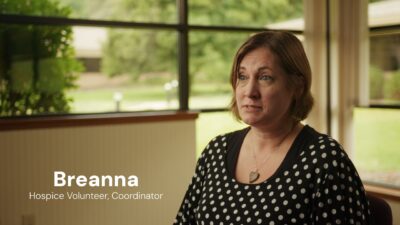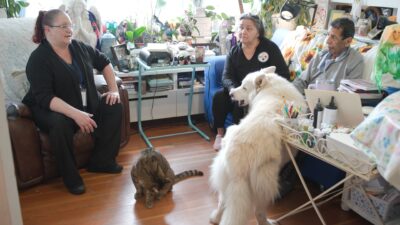Have questions? We can help.
Read common questions we receive and answers from our experts.
Hospice Foundation of America provides confidential guidance to patients, families, and healthcare and social service professionals regarding care at the end of life and bereavement. HFA is not a direct service healthcare provider and does not monitor or regulate hospice providers. Information and education provided through this service does not establish a patient-client relationship.
How hospice helps
When serious illness strikes, most patients and their families initially hope to stop or alter its course by exploring aggressive or invasive treatments. At the end of life, most people hope for quality of life, comfort, peace, and to be near loved ones and familiar possessions. Hospice helps to achieve those goals.
With hospice, your mother’s quality of life will be the top priority. A physician and a registered nurse will oversee management of pain and other symptoms, while a team of professionals provides support with daily functions and non-medical care, as well as psychosocial and spiritual needs.
Hospice does not speed up or delay the dying process. The focus of hospice care is solely to relieve symptoms such as pain, anxiety, and breathlessness at the end of life, allowing natural death to occur in peace and with dignity. The medications used at end of life are for symptom relief only and are never used to hasten death.
Yes, he can. Hospice encourages the patient’s family doctor or specialist to remain engaged in their care. The hospice physician will communicate with your father-in-law’s family doctor, who may know the patient better (medically) than anyone else, to determine the specific medical needs addressed in his individual plan of care.
Hospice eligibility
Feel free to ask the doctor for an eligibility assessment to see if your grandmother is eligible for hospice care. Hospices consistently hear that patients/families wish they had received hospice care sooner, so it is a good idea to let the physician know that you are open to discussing this option at the appropriate time.
If you prefer, contact a local hospice directly to learn more about their services. Patients and families may reach out directly; a physician’s referral is not required for the initial call.
Yes. Hospice care is available to people of any age, so long as they meet eligibility requirements.
Guidelines regarding hospice care for patients under 18 are different than those for adults; they allow for “concurrent care” that includes efforts focused on both cure and comfort.
Yes. In fact, people with dementia comprise the fastest growing patient population for hospices.
When hospice began in the United States in the mid-1970s, most people receiving hospice care had cancer. While hospices still care for cancer patients, the majority of people entering hospice today have other life-limiting illnesses such as end-stage heart disease, neurodegenerative conditions such as Parkinson’s disease, lung or kidney disease, or Alzheimer’s and other dementias.
You do not need to be actively dying to receive hospice care. Because your oncologist has given you a prognosis of less than six months, with no further treatment options available, you are more than likely eligible to receive hospice services now.
Early hospice care can give patients time with family, friends, and pets, as well as symptom management and other support. Although hospice care neither hastens death nor prolongs life, studies show that patients with certain illnesses live somewhat longer with hospice care than those with the same illness who do not choose hospice care.
Rules and regulations
Yes, you are free to leave a hospice program at any time, for any reason, without penalty. And you are permitted to re-enter hospice care as long as you meet medical eligibility criteria at the time of your re-enrollment.
You are free to change hospice providers if you are unhappy with the care provided. Under the Medicare benefit, this is allowed once during the patient’s initial 60-day certification period, or once during the 60-day benefit periods that follow.
Yes, your brother can go home and receive hospice care there. A DNR is not required.
The purpose of hospice care is to allow for a peaceful death in a comfortable and familiar setting. Many people who choose hospice care wish to have a DNR order in place to avoid unnecessary medical intervention, but having a DNR is not a condition for receiving hospice care.
All patients receiving hospice care are required to have a prognosis of six months or less if their disease continues to progress as expected. However, predicting the actual date or time of death is challenging. If your father continues to meet the eligibility requirements for his terminal condition and shows continuing evidence of decline, he can remain in hospice care beyond six months.
If at some point he does not meet eligibility standards, federal rules require the hospice to discharge him from their care. Upon discharge, his Medicare benefits would revert to the coverage he had before entering hospice care.
Although state and local regulations can be barriers in some places, people with IDD usually can receive the same hospice care provided to any patient/family. This applies even if they live in a group home or other residential setting, where services may include support for direct-care staff.
It is important to recognize that many people with IDD have the capacity to participate in decisions about their end-of-life care, whether through an advance directive or in conversation. They should be informed about their illness, the options available, and the type of care those choices involve.
Yes, you can go to the hospital. Your hospice team will provide all aspects of care for the illness that qualifies you for hospice services, but like all hospice patients, you are free to seek treatment for conditions or illness unrelated to your hospice care. You must revoke your hospice benefit for the period of your hospitalization.
Where hospice is provided
The majority of hospice patients receive care in their place of residence, which may be a private home, assisted living community, or long-term care facility. In some instances, hospice care is provided in an inpatient hospice setting — typically for people whose pain or other symptoms cannot be adequately managed in their home.
Hospice is a philosophy and type of care, not a place to go. While your uncle is receiving excellent care in his nursing home, hospice can provide reassurance that he is receiving optimal care and symptom management during the time that remains.
For example, hospice can provide medications related to his terminal illness, expert management of pain and problems with breathing or swallowing that can occur at the end of life, and comfort care, if needed. The hospice team also can educate nursing home staff.
Keep in mind that the hospice benefit does not cover the cost of housing a patient in a nursing home or assisted living facility (also known as daily room and board fees) except under highly limited circumstances. However, nursing home and assisted living costs may be covered by Medicaid or other sources such as VA housing benefits or supplemental long-term care insurance.
Caregiving and feeding issues
A patient may refuse food and fluids due to physical discomfort or pain, the side-effects of medication, depression, or simply a decreased sense of taste or smell. It also can mean that your grandmother is nearing the end of her life and, despite your best efforts, her ability to tolerate food and fluids is declining as her bodily functions begin to slow down.
A clinical assessment is the best way to determine the root cause of your grandmother’s behavior. Her primary care provider may refer her to hospice if her refusal of food is a symptom of end-stage dementia.
In the meantime, offer very small portions of her favorite foods and drinks more frequently throughout the day. This may be more enticing than larger meals at prescheduled intervals.
Many patients come into hospice with a feeding tube in place. Assuming he meets the eligibility criteria, a feeding tube alone would not disqualify him from receiving hospice care.
Total Parenteral Nutrition (TPN) can be a life-saving therapy when used temporarily under close medical supervision in an acute-care setting where frequent blood samples can be taken and the TPN formula adjusted as needed.
For hospice patients in residential settings where medical supervision, blood draws, and lab work are not available around the clock, TPN can increase the risk of adverse side effects and contribute to life-threatening complications.
Ethical guidelines, based on evidence-based studies, recommend not providing TPN if the risks and side effects outweigh the benefits. At the end of life, intravenous fluids in any form can increase the risk of fluid overload, resulting in increased swelling (edema) in the extremities, along with heart and lung congestion.
Learn more about medical and ethical challenges at the end of life.
Caregiving and safety concerns
Your hospice provider will ensure that durable medical equipment and assistive devices are in place before your father transfers to your home. Once he arrives, the hospice nurse, home care nurse, or an occupational or physical therapist can help you ensure that appropriate modifications are in place.
For example, if your father is at high risk of falling, hospice can deliver a hospital bed that can be lowered closer to the floor at night or when he is in bed and unsupervised. The provider also may bring in “fall floor mats” that can be placed bedside.
For more ways to make your home safer, read a list of safety tips for hospice patients at home.
As your friend’s care needs increase, it may be time for his family to consider another living arrangement, including moving him to a location where around-the-clock supervision is available. The assisted living (AL) staff will probably recommend when this is appropriate.
Talk to his sister and suggest that she quickly arrange a meeting with the AL facility’s case manager, the primary hospice nurse and/or social worker, concerned family members, and your friend. Together, they should evaluate options and develop a care plan that addresses his evolving needs.
Until a longer-term plan can be implemented, review a list of tips for keeping dementia patients safer at home or in assisted living facilities.
Experiencing grief
We all experience grief differently, but rest assured that your behavior is normal. Grief can affect us emotionally and cognitively, causing us to be distracted and do things that we don’t typically do. In most cases, these new behaviors and thoughts gradually fade and eventually disappear as we move through the mourning process.
If you find it difficult to get back to your previous level of functioning several months after your loss, seek out a grief counselor or support group. If grief is negatively affecting your health, seek medical care and inform your healthcare provider of your recent loss.
Grief is not a predictable set of stages; we each experience grief in our own way, at our own pace. Some people may feel anger over a death, but others do not.
Grief has no timeline and no order. In fact, there is no right or wrong way to grieve unless you engage in self-harm or harm others as a result of your loss. Most people experience grief like a roller-coaster, with ups and downs, good days and bad days. Grief typically lessens as time passes, allowing you to return to previous levels of functioning, both in your personal and professional life.
Many grievers find great comfort, and often a profound sense of relief, when a loved one dies after a long and difficult illness. Having the opportunity to say good-bye to your husband, and knowing there was little you could do to prevent the loss, may have positively affected your grieving process.
Studies show that grievers who have significant social support or a strong sense of spirituality often face grief with resilience. There is no need to worry if you are doing better than you expected.
Children, teens, and grief
Most experts believe children do not have a mature understanding of death until about age 8 or 9. Younger children may think that being dead is temporary and the dead person will return in the future.
Many children have some understanding of death by age 5, however, and even toddlers and infants can be deeply affected by a person’s absence and other family members’ grief. Keep in mind that children develop at different rates, so what holds true for one child may not apply to another.
Use precise language when talking about death. Adults use many euphemisms, such as “losing” a loved one. Children may interpret this literally and assume that the person got lost and can be found.
Religious platitudes also can be confusing. Telling a child that a person is now “in a better place” may lead the child to question why that better place is not with the child, or why the child isn’t in that better place too.
If a child does not understand the finality of death, gently explain that being dead means that the body has stopped working and it can’t be fixed. It no longer feels cold or gets hungry, and it does not feel any more hurt or pain.
Your children most likely are highly aware of your sister’s progressive and life-limiting illness. When she begins hospice care, ask your hospice social worker or bereavement counselor for guidance. Their professional support will be helpful for you and your children.
In addition, books about death and grief, social stories that explain similar situations, or movies that address the subject can help to prepare them.
This doesn’t mean that your 10-year-old didn’t love his grandmother, nor is he being disrespectful. Children cannot tolerate long periods of sadness; they may need to play and take part in their usual activities. It is OK to permit, or even encourage, children to have fun just as they did before the death.
Like many adolescents who are grieving, your daughter may be feeling highly emotional, especially if this is the first time she has experienced a family member’s death. At her age, she likely finds more comfort in talking with her friends than with adults.
Grief experts generally agree that funerals and memorial services can be helpful for children, but it is important to prepare them in advance. Let them know, in general, what they are likely to experience during these events. Once your children have that information, let them make a choice about how to be involved or whether to attend.
You may wish to ask a friend or relative who was not close to the deceased to serve as a chaperone while you are preoccupied with the funeral. Younger children, in particular, may have a limited attention span and need to take breaks during the ceremony.
Children who choose not to attend the funeral should not be punished or made to feel guilty for their decision. Be sure they are cared for during your absence.
If your children have questions that you can’t answer, it’s OK to say that you don’t know. You can even say, “No one knows for sure, but this is what I think.”
Younger children often feel highly vulnerable when a parent or other close adult dies, and they may incorrectly believe that the death was somehow their fault. Stress that your brother didn’t die because of anything they did or didn’t do, said or didn’t say.
If a child asks whether you will die, respond that everybody dies someday, but that you hope and expect to live for a long time. Consider visiting your doctor for a checkup. This can reassure your children that you are taking steps to stay as healthy as possible.
It may help older children to talk with a healthcare provider who can answer their specific medical questions. Offer them the opportunity if you can.
Yes, you should make teachers, coaches, and others within your son’s immediate circle aware of the death. This can be helpful for children of all ages, especially when a close family member or friend dies.
Older children and teens may experience intense emotions and find school academically and socially challenging after the death of a loved one. School-age children may feel isolated in their grief and believe that others don’t understand what they are feeling.
When you are grieving, the responsibility of supporting a child or teen can feel like another layer of complexity in your life. Don’t hide your grief. Assure your daughter that you will be there to support her and that you will adjust to your shared loss together.
Studies have shown that children whose surviving parent manages grief well are better able to cope with loss themselves. The hospice that cared for your wife can provide grief support to you and your daughter. Often, hospices offer support groups tailored to both the age of the bereaved and their relationship with the deceased.
At any age, changes in a bereaved child’s behavior can be a warning sign. In these instances, it’s appropriate to seek advice from a counselor who specializes in child and adolescent bereavement.
Many hospices provide grief support for everyone in their community, including support groups for children and adolescents, regardless of whether the death occurred in hospice.
Adjusting to suicide loss can be particularly difficult, and siblings’ grief sometimes is disenfranchised by others who focus their concern primarily on parents.
Children, adolescents, and adults with developmental disabilities grieve, but their expressions of grief may be misinterpreted.
For example, many individuals with autism are concrete thinkers; they might easily grasp that a person is dead but struggle to identify their feelings about the person’s absence or how their life and routine may be affected.
Don’t assume that your brother lacks understanding or isn’t feeling sad. An unexpectedly calm demeanor may indicate that an autistic person is overwhelmed. Reassure your brother, include him in decisions, discussions, and events, and do not criticize his grief reactions or lack of reaction.
Yes, children can be diagnosed with prolonged grief disorder six months after a loss. Symptoms include preoccupation with the death, distress over the manner of death, and the wish to avoid reminders of the person who died. If you are concerned that your child or adolescent is exhibiting these behaviors, contact a counselor in your area.
Moving ahead while grieving
For most people, the pain of grief lessens over time, but that doesn’t mean we forget about the person who died. Even after death, the bond will always last.
It’s normal to feel afraid that if you let go of grief, you will lose the connection with your wife. But death doesn’t end the bond. There are meaningful ways to keep that connection, even without her presence, as you move on with your life.
The most important thing you can do is be gentle with yourself. You will have good days and bad days, particularly when your loss is new. On those rough days, don’t be discouraged if you can’t accomplish all that you wished to do.
You may want to ask a trusted colleague to speak with your coworkers before you return and act as your spokesperson during your first days back on the job. Understand that coworkers may not be aware of your loss, might not know what to say, or may unintentionally say something hurtful. On the other hand, it may help to share your grief with those who offer support.
Consider taking advantage of any resources available through your workplace’s HR office or employee assistance program. These programs can offer information, support, and counseling to help you fulfill your duties while experiencing grief.
Everyone experiences grief in their own way. What works for your siblings may not work for you.
Some people read books or poetry to help them understand and work through their grief. Others find journaling to be helpful — it’s a way to privately process your feelings and gain valuable insights about ourselves as we move along in our grief journey.
Holidays can be challenging times to grieve, and social gatherings may intensify — or help to ease — your grief. It’s up to you to decide who you want to be with and what activities you wish to join.
The Three Cs of Coping with Grief During the Holidays is a useful guide. It suggests that you:
· Choose ways to acknowledge your loved one, such as lighting a candle or giving a holiday toast. This can bring a positive focus to grief.
· Communicate what is important to you, and discuss your choices with others, especially those people your choices affect. They may be grieving too, and their needs may be different from yours.
· Compromise with those whose expression of grief differs from yours. This can help to alleviate painful feelings.
Nothing changes the fact that holidays can be especially difficult while you are grieving, but you may find renewed strength and hope as you navigate their challenges.
Grief and special populations
Your sister may know more than you realize, but if it is difficult to determine her level of understanding, family members should gently make her aware of your mother’s condition.
This can be done by “dosing” information at the appropriate level for her. You don’t need to tell her everything at once, but don’t minimize the seriousness of your mother’s condition or lie about what is ahead. Social stories are an effective way to communicate difficult topics to individuals with IDD.
Grief is a highly individual experience, but people with IDD often form deep attachments to those they love and those who care for them. The death of a parent — or of another relative, friend, neighbor, caregiver, employer, pet, or service animal — can have a significant impact. Some people with IDD are in turmoil after a death, while others move on with little difficulty.
Like anyone who loses a loved one, people with IDD need the support of friends, family, and community members. It is important to reassure your sister that you and your siblings will be available to support her.
Grief experts agree that funerals and other rituals can help children with their grieving process. Children of any age can attend a funeral with proper preparation and guidance.
However, they should never be forced to attend a funeral or view an open casket. If a child clearly does not want to attend, do not force them. Make sure that a responsible, caring adult is available to provide supervision and support while you are unavailable.
Before children attend a funeral, let them know what to expect to the degree possible. Explain that there may be tears, as well as laughter. Give them a role to play, such as writing a letter or drawing a picture to be placed near the casket, or distributing flowers or programs to guests. Older children might curate a playlist of songs for the funeral or reception.
Young children may need a chaperone who is not a grieving, preoccupied family member or friend. This person can accompany the child during the funeral and provide opportunities for distraction when needed.
Need help finding answers?
Submit your question to receive personalized, confidential guidance from an HFA expert.
Other resources you may find helpful
What do hospice volunteers do?
Hospice volunteers are an integral part of the hospice team. Watch this 5-minute video to hear personal experiences of hospice volunteers at Hospice of Michigan. Are you ready to become a hospice volunteer?
Improving Dying
HFA recently profiled end-of-life care innovations during a continuing education course, Improving Dying, which showcases exceptional care programs that are enhancing care for patients, families, and even entire communities. These special programs go the extra mile to provide excellent patient care, ease caregiving and grief, and raise public awareness of the humanity and dignity that…
A Butterfly Has Been Released
This film is available to rent for 72 hours for $4.99.



